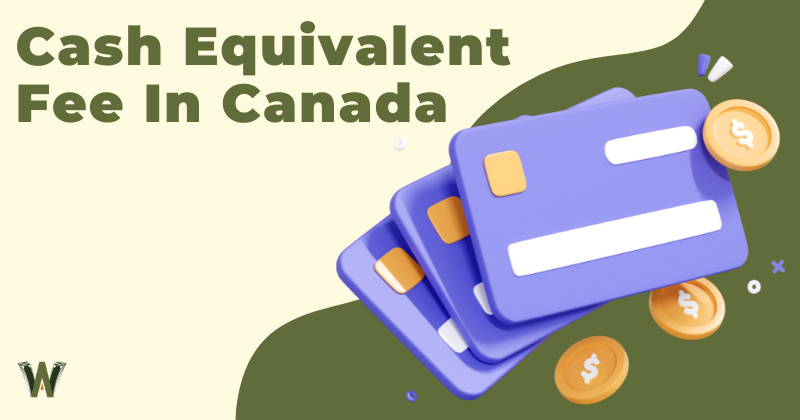If you’ve recently used your credit card to withdraw money from an ABM or to receive a cash advance, then you may notice a cash equivalent fee on your credit card statement. If you’ve never received one before, this may seem a bit alarming.
A cash equivalent fee in Canada are additional fees and charges imposed on cardholders who use their credit cards to withdraw cash or who use their card to cover cash balances.
If you’re curious about learning how cash advances work in Canada, when cash equivalent fees are charged, and how to avoid them, then you’re in the right place. Below, I’ll give you a quick crash course on cash equivalent fees and how they can affect your credit card account.
Understanding Cash Equivalent (Cash Advance) Fees In Canada
As the name implies, a cash equivalent fee is charged when you attempt to use your credit card in place of cash. Credit cards are meant to be used on the card network. While credit card companies allow cardholders to use their cards for a cash advance, they charge a fee for doing so.
Most credit card companies charge between 3% and 5% as a cash equivalent fee. This fee is charged on the amount of the cash-like transaction.
For example, if I use my Canadian Tire credit card to initiate a cash advance and transfer $1,000 to my bank account, then my bank would charge me a 3% fee for the transaction (which would be equivalent to $30 in this case).
Why Do Credit Card Companies Charge Cash Equivalent Fees?
Whenever you use your credit card for cash-like transactions, you essentially use your credit balance as a loan. To the credit card company, this indicates several potential red flags, such as:
- You may not be able to receive a loan from a traditional lender
- You’re in desperate need of fast cash
- You’re not a responsible credit card user
A credit card cash advance is just as good as cold hard cash. The only difference is that the majority of lenders make borrowers go through an approval process to receive a loan.
Being the money-making corporations that they are, credit card companies won’t hesitate to capitalize on this. If you’re using their card in a way that they don’t expressly intend, then they’re going to take their cut.
When Are Cash Equivalent Fees Imposed In Canada?
Cash equivalent fees are typically imposed on cash-like transactions and transfers that you perform using a credit card. If this seems a bit vague, here are some common instances when you may be charged a cash equivalent fee:
- When you use your credit card to withdraw cash
- When you use your credit card to transfer money into a debit account
- When you use your credit card to purchase a money order
Using Your Credit Card At An ABM
Some credit card companies allow cardholders to use their credit card at a standard ABM, the same way that they might use their debit card.
If you use your credit card like this, then you’ll almost certainly be charged a cash advance fee on the amount that you withdrew, in addition to any fees charged by the ABM for using an out-of-network card.
Asking For A Cash Advance
Most credit card companies allow users to receive a cash advance, which is when you transfer a portion (or all) of your available credit card balance to your chequing account.
Receiving a cash advance is very similar to the process of applying for a small loan, which is why credit card companies impose a cash advance fee.
Using Your Credit Card To Purchase A Money Order
Be careful before attempting this. Here’s an example of a university student using their credit card to purchase a money order:
Student: “The first time that I made this mistake, I was in university and was about to pay my monthly apartment rent. My chequing account balance was a bit low, so I had the brilliant idea of using my credit card to purchase a money order to pay my rent.
Unfortunately, the grocery store I was trying to purchase the money order at denied me and explained that I could only purchase money orders with cash or a debit card. They explained that that was just their store’s policy and that I may have better luck elsewhere.
Eventually, I found a money order service that was willing to take my credit card. However, they informed me that my credit card company would likely charge a cash advance fee since money orders are considered to be cash transactions.”
The point is to look carefully at the fine print before attempting to purchase a money order using your credit card.
What Is The Most You Can Get From A Cash Advance?
The maximum amount you can get from a credit card cash advance depends on your credit card company, your current account balance, and your card’s spending limit. Most credit card companies won’t give you a cash advance on the card’s full spending limit, though.
Cash Advance vs. Balance Transfer In Canada: What’s Better?
Cash advances and balance transfers are two services offered by most major credit card companies. As we’ve discussed, cash advances provide the cardholder with a cash amount transferred to their bank account. Balance transfers are another story, though.
A balance transfer is when you apply your credit card’s spending limit to another debt you owe. One of the most common examples of this is when you open up a new credit card to pay off an old credit card at a lower interest rate. Balance transfers may also be applied to auto loans and other lines of credit.
Balance transfers are generally a more responsible way to use your credit card balance, as they typically incur lower fees than a cash advance.
- Related Reading: The best balance transfer cards in Canada
Can A Cash Advance Hurt Your Credit Score In Canada?

The whole point of a credit card is to use it responsibly so that you can build your credit score and unlock credit card rewards. Generally speaking, a cash advance (and any ensuing cash equivalent fees) won’t directly affect your credit score.
However, if you’re not smart about taking care of the cash advance, then it could detrimentally affect your credit score. Here’s how a cash advance could indirectly hurt your credit score:
- It will increase your credit card balance, lowering your total available credit (a metric used to determine your credit score)
- It could result in additional interest penalties and late payment fees if you don’t quickly pay the amount back
- Failure to pay a cash advance back could result in your credit card company closing your account and sending your debt to a collection agency, which could harm your credit score
Pros & Cons Of Getting A Cash Advance In Canada
Having the option to use your credit card for a cash advance can certainly come in handy. However, it also comes with several drawbacks that are worth noting. Here’s a quick overview of the pros and cons of cash advances in Canada.
- You get access to funds quickly
- You don’t have to go through a traditional loan application and approval process
- You may be able to use your credit card like a debit card to withdraw cash from an ABM
- A cash advance won’t mark your credit report with a hard inquiry (like traditional unsecured loans will)
- A cash advance usually comes with cash equivalent fees, which can cost between 3% and 5% of the advance amount
- A cash advance won’t help you build your credit score by diversifying your lines of credit
- A cash advance, if not paid off on time, can hurt your credit score
FAQs About Cash Equivalent Fees In Canada
Before we finish up, here are a few quick answers to some of the most commonly asked questions I’ve received from readers about cash advances and cash equivalent fees in Canada.
Are Cash Equivalent Fees Legal In Canada?
Unfortunately for consumers, credit card companies in Canada are legally permitted to charge cash equivalent fees on cash-like transactions such as cash advances, money order purchases, or ABM cash withdrawals.
Can You Get A Cash Advance With Any Credit Card?
Most major card companies allow cardholders to use their account balance for a cash advance. However, some credit cards cannot be used for a cash advance. To verify, you should check with your card company first.
How Much Are Cash Equivalent Fees In Canada?
Cash equivalent fees in Canada differ depending on the credit card company and the card that you’re using. Most banks and credit card companies impose a 3% cash equivalent fee, but some may charge up to 5%.
Additionally, some credit card companies apply a minimum cash equivalent fee, regardless of how small your cash advance is. For example, a card may charge a 3% cash equivalent fee with a minimum of $10. In this case, if you were to use your card for a $100 cash advance, then your total fees would equate to 10% of the total cash advance (which is incredibly high).
Can Cash Equivalent Fees Be Waived In Canada?
Cash equivalent fees are usually charged automatically by credit card companies. However, if you’ve just recently opened a credit card account and it’s your first time, then your first cash equivalent fee may be waived. Don’t count on this, though, as policies vary from one card provider to the next.
Conclusion – Avoid Cash Equivalent Fees In Canada If Possible

Cash equivalent fees can be rather pricey. If you have decent credit, then you’re probably better off getting a traditional loan. However, if you don’t have the greatest credit and you need to access emergency funds, a cash advance could be your best solution.
Of course, an even better solution would be to have an emergency savings fund, so you don’t have to use a cash advance or apply for a loan. Although it may seem complicated, saving is actually a lot easier than it seems. Keep on reading to see my post on 101 sensible ways to save money in Canada!




